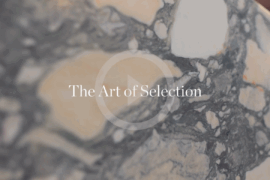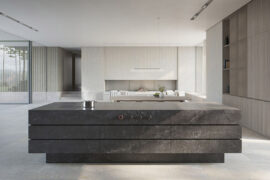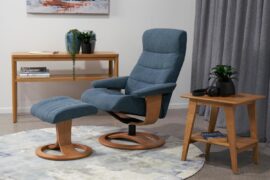Vo Trong Nghia Architects finds an innovative way to bring greenery back to the concrete jungle that is Ho Chi Minh City.

October 30th, 2014
Ho Chi Minh City, Vietnam is known for its traffic congestion and air pollution, with only 0.25 per cent of the city covered with greenery.
With House for Trees, Vo Trong Nghia Architects has designed a low-budget, prototypical house in an effort to address this situation; the aim of the project is to bring green space back into the city by accommodating nature in high-density dwelling.
Five concrete box-like buildings are designed as ‘pots’ with trees at their tops. With a thick soil layer, these pots also function as storm-water basins; when multiplied to a large number of houses in the future, the idea is that this type of housing will help to reduce the risk of flooding in the city.
The house is located in Tan Binh district, one of the most densely populated residential areas in Ho Chi Minh City. The site is a remnant landlocked block within this suburb, accessed only by a small pedestrian lane. Resonating with this urban tissue, the house is designed as an accumulation of ‘small fragments’ and, surrounded by typical Vietnamese row houses on all sides, it stands out like an oasis.
Fitting into the informal shape of the site, the five boxes are positioned to create a central courtyard and small gardens in between. The boxes open to this central courtyard with expansive glass doors and operable windows to enhance natural lighting and ventilation, while remain relatively closed on the other sides for privacy and security.
Common spaces such as the dining room and library are located on the ground floor. Upper floors accommodate bedrooms and bathrooms, which are connected through bridge-cum-eaves made of steel. The courtyard and gardens, shaded by trees above, become part of the ground floor living space and blur the boundary between the indoors and outdoors.
Local and natural materials have been used to reduce cost and carbon footprint. The external walls are made of in-situ concrete with bamboo formwork, while locally-sourced bricks are exposed on the internal walls as finishing. A ventilated cavity separates the concrete and brick walls to protect the interior space from heat transfer.
Vo Trong Nghia Architects
votrongnghia.com
INDESIGN is on instagram
Follow @indesignlive
A searchable and comprehensive guide for specifying leading products and their suppliers
Keep up to date with the latest and greatest from our industry BFF's!

CDK Stone’s Natasha Stengos takes us through its Alexandria Selection Centre, where stone choice becomes a sensory experience – from curated spaces, crafted details and a colour-organised selection floor.

For those who appreciate form as much as function, Gaggenau’s latest induction innovation delivers sculpted precision and effortless flexibility, disappearing seamlessly into the surface when not in use.

The Vietnamese architect discusses insatiable construction markets and dwindling urban ecologies. For the latter, he recommends bamboo; for the former, meditation.

A trip to the cinema in Ho Chi Minh City, is not just a matter of viewing the latest blockbuster these days but there is also the chance to enjoy the cinema itself – through a design that takes colour to another level entirely.
The internet never sleeps! Here's the stuff you might have missed

Architects Declare and Suppliers Declare are uniting with the aim of making transparent, responsible specification the new industry standard.

Your main seating can be a stylish centrepiece, not just a functional chair.